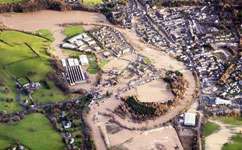Man-made drainage could raise risk of flooding

Installing drainage systems in developing towns and cities can cause water to reach rivers more quickly, potentially raising the risk of flooding, say scientists.
New research, published in the Journal of Hydrology, says storm drainage systems can result in higher peak flows that rise and recede more quickly.
It suggests that, in some cases, storm drains may do more to increase the risk of flooding than changes in the land surface.
Its authors hope their research will help to guide future planning decisions, particularly in areas where the city meets the countryside.
'When we're thinking about urban developments, we need to start thinking about the land use in terms of its hydrological impacts,' says James Miller, of NERC's Centre for Ecology & Hydrology, who led the study.
'It's not just the changes at the surface that matter – what goes on beneath with drainage and the retention of water is just as important.'
'New urban development tends to be really dense, and requires a lot of engineering. Allowing for some space and design would be really beneficial in some places, but the planning issues are very entangled.'
The team measured rainfall, runoff and evaporation in two adjacent river catchments in Swindon, UK, over 2011 and 2012. One was heavily urbanised, while the other was relatively new fringe development on previously rural land, which scientists call 'peri-urban'.
The peri-urban catchment contained two distinct drainage systems – one with a mixture of natural and man-made drainage, the other dominated by a storm drainage system.
Analysis showed that storm drains influenced the speed at which water reached the river more than either impermeable land cover or the type of development.
The team also used historical maps to simulate the hydrological effects of urban development from the 1960s to the 2010s.
They found that, following the introduction of a large-scale storm drainage system to the peri-urban area in 2010, floods lasted half as long on average, but peak river flows increased by over 400 per cent compared with the 1960s.
The team are now monitoring rainfall and runoff across a number of urban catchments throughout the UK.
A recent study by the Met Office and Newcastle University predicted that global warming could cause extreme summer downpours to become several times more frequent in the UK by 2100, potentially leading to more flash flooding.
'Storm drainage is needed to quickly remove water from impermeable land in towns and cities,' says Miller. 'But future developments will need to consider how they will mitigate the combined effects of this and the possibility of more frequent intense storms.'
More information: James D. Miller, Hyeonjun Kim, Thomas R. Kjeldsen, John Packman, Stephen Grebby, Rachel Dearden, "Assessing the impact of urbanization on storm runoff in a peri-urban catchment using historical change in impervious cover," Journal of Hydrology, Volume 515, 16 July 2014, Pages 59-70, ISSN 0022-1694, DOI: 10.1016/j.jhydrol.2014.04.011.
Provided by PlanetEarth Online

















